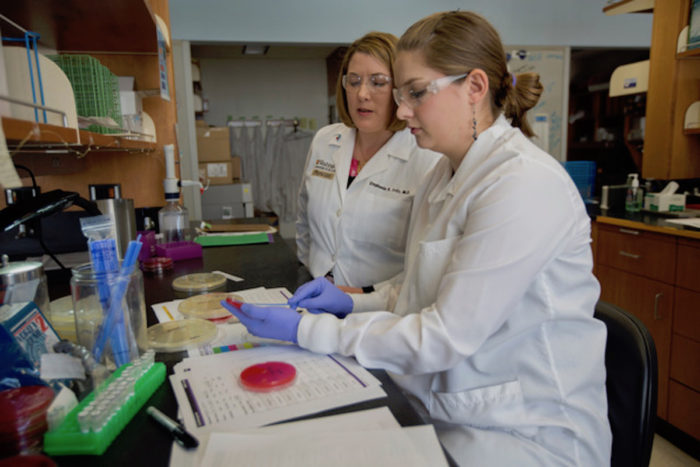Antibiotics warranted for kids with minor staph infections
Drugs reduce risk of recurrent infection
 Karen Elshout
Karen ElshoutStephanie A. Fritz, MD, (left) an associate professor of pediatrics at Washington University School of Medicine in St. Louis, analyzes the bacteria commonly known as staph with Carol Muenks, a clinical research coordinator. Fritz and her research team have found that prescribing antibiotics is warranted for children with minor staph infections. The drugs help to reduce the risk of recurrent infections.
The overuse of antibiotics has left some doctors questioning whether to give such drugs to children diagnosed with uncomplicated staph infections. Such infections often occur on the skin and look like a pus-filled bug bite.
Now, research led by Washington University School of Medicine in St. Louis indicates that prescribing antibiotics — in addition to lancing and draining staph-infected areas — reduces the risk of recurrent infections.
The study, conducted with researchers at Southern Illinois University School of Medicine, is published online in the journal Clinical Infectious Diseases.
“There have been conflicting data about the benefit to antibiotics in minor staph infections,” said the study’s senior author, Stephanie A. Fritz, MD, a Washington University associate professor of pediatrics in the Division of Infectious Diseases. “It is definitely important to surgically remove pus from the infection site, but also giving antibiotics means that the child will be less likely to see a doctor again in several months for another staph infection.”
In the study, the researchers evaluated 383 children — with a median age of 3 years old — whose infections with the bacteria Staphylococcus aureus (staph) required incision and drainage. The patients also had colonization of staph in their nostrils or on their skin.
The children were evaluated for the bacteria and reinfection several times over a year; of these patients, 355 (93 percent) received antibiotics coupled with incision and drainage treatment.
A month after initial infection, bacterial swab tests found that half of the children (178) who had received antibiotics had no signs of staph living on their skin or in their nostrils, reducing the risk of recurring infection. However, the bacteria remained on the skin of about three-fourths of the children (26) who did not receive antibiotics.
Additionally, children who remained colonized with staph a month after initial infection were about twice as likely to experience a recurrent infection than those who did not have staph on their skin. That’s 101 children (60 percent) compared with 54 children (30 percent).
Staph generally live harmlessly on the skin in about one-third of the human population, Fritz said. However, staph infections have become a worsening health problem, affecting not only those with weakened immune systems but otherwise healthy children and adults.
At St. Louis Children’s Hospital, where Fritz treats patients, about 50 children are hospitalized each year with staph infections. Overall, about 800 children admitted to the hospital’s emergency department each year have staph infections; most are treated and discharged.
“In recent years, studies have demonstrated that staph infections are prominent in both hospitals and in the community,” Fritz said. “For example, we have seen a dramatic increase in community-associated infections since 2000.”
Staph may become life-threatening when it enters the bloodstream, bones or organs through skin-to-skin contact or by touching a contaminated object. When an infection turns serious, health-care workers typically give patients intravenous antibiotics.
However, some health-care workers have hesitated prescribing antibiotics for children with minor staph infections because of increasing antibiotic resistance. The most common such strain is known as methicillin-resistant Staphylococcus aureus, or MRSA, which may cause pneumonia, severe organ damage and death. The Centers for Disease Control and Prevention reports that 11,000 adults and children die annually of MRSA infections.
Although it might seem counterintuitive, prescribing antibiotics for minor staph infections helps to reduce antibiotic resistance, said the study’s first author, Patrick Hogan, a clinical research specialist at the School of Medicine. “Using antibiotics judiciously to treat staph infections eliminates staph colonization and prevents more infection from occurring in the future,” he said. “This reduces the overall burden of the staph germ on the environment and people, which results in less recurrence and, therefore, less antibiotic use.”
The study primarily evaluated the antibiotics clindamycin and trimethoprim-sulfamethoxazole (TMP-SMX). Of the two drugs, clindamycin was the most effective at eliminating staph colonization and preventing recurrent infection. Why clindamycin was superior to other antibiotics is unknown and warrants further study, Hogan said.






